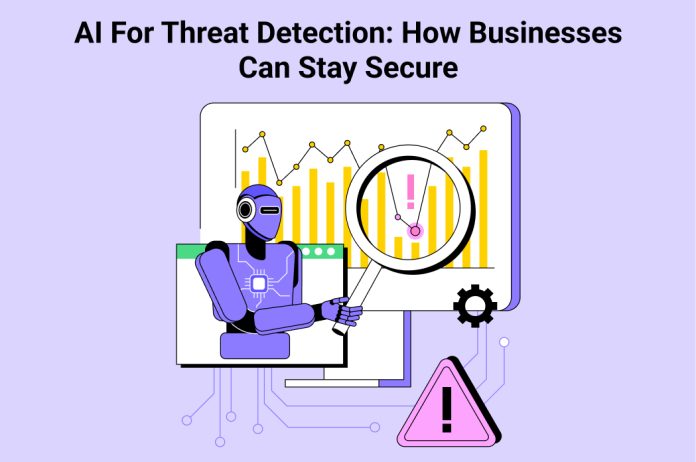Learn how integrating AI for threat detection empowers your business to identify cyber threats, ensuring robust security and resilience proactively.
Data is both a company’s most valuable asset and its biggest weakness in today’s hyper-connected world. Businesses have built digital fortresses out of code walls protected by firewalls, intrusion prevention systems, and antivirus software. But enemies have come a long way since the simple lockpicks of the past. They now wield digital crowbars, cognitive engineering, and stealthy exploits that slice through traditional barriers like a laser through silk.
Cyberattacks today are so large, prevalent, and complex that signature-based security is no longer sufficient. It’s like having a guard with a clipboard standing against a whole army of cyber thieves. The way things used to be has changed. The battlefield is no longer a fixed place; it is constantly changing, shifting, and evolving. Businesses need to use sentinels that think, learn, and change faster than the threat itself to protect it.
Enter AI for Threat Detection—the vigilant digital guardian of the modern era. This isn’t the flavor-of-the-month jargon. It’s a tectonic realignment of how we envision cybersecurity. For forward-thinking businesses, implementing AI in cybersecurity is not a luxury but a lifeline.
In this blog, we examine how artificial intelligence for cybersecurity services is revolutionizing threat detection and prevention, and how enterprises can utilize it to maintain a competitive edge in the digital security landscape.
Table of Contents
The Crumbling Ramparts: Where Legacy Defenses Falter
For decades, cybersecurity was a reactive duel —a relentless cycle of defense and damage control. When early malware strains, such as the “I-LOVE-YOU” worm, wreaked havoc, defenders would study its digital DNA, craft a signature, and deploy it as an antidote. This worked—until adversaries evolved.
Today’s threats are intelligent shapeshifters:
- Zero-Day Exploits: They strike from the shadows, exploiting unseen flaws before patches exist, bypassing every known signature.
- Polymorphic Malware: Like a chameleon cloaked in code, it continually morphs its structure, confounding static scanners.
- Fileless Attacks: Dwelling within a system’s memory rather than files, they slither undetected past traditional detection tools.
- Alert Fatigue: Security teams drown in avalanches of false positives—millions of logs per day; until real threats slip through unnoticed.
The Achilles’ heel of conventional defense is simple; it only recognizes what it has seen before. But cybercriminals thrive in the realm of the unknown. And therein lies the battlefield where AI-driven threat detection rises; an approach that doesn’t ask, “What’s bad?” but instead inquires, “What feels wrong?” This is the bedrock of modern cyber threat detection and response.
READ ALSO: How AI Is Reinventing Cybersecurity: Smarter Defense for a Digital World
The Digital Vigilante: How AI-Driven Threat Detection Operates
What exactly does AI for Threat Detection entail? Imagine a tireless sentinel capable of sifting through billions of events per second, discerning the difference between harmless noise and malicious intent, with unerring precision. The machinery behind it rests on two cornerstones: machine learning for threat detection and behavior-based threat detection.
1. Machine Learning – The Cerebral Cortex of Cyber Defense
Unlike static, rule-bound systems, machine learning for threat detection evolves perpetually.
- Supervised Learning: It’s trained on enormous datasets teeming with examples of both benign and malicious behavior. It discerns digital fingerprints, learning to separate a harmless ping from a hostile probe.
- Unsupervised Learning: This is where it transcends human capacity. Fueled with unfiltered network data, it autonomously constructs a behavioral baseline —an organic understanding of “normal.” Anything deviating from this baseline is met with scrutiny.
2. Behavior-Based Detection – The Digital Guardian’s Instinct
Picture a security officer who has memorized the rhythm of your enterprise.
He knows that:
- The finance department accesses sensitive ledgers between 9 AM and 5 PM.
- Servers communicate through defined channels and ports.
- Marketing doesn’t meddle with engineering repositories.
When behavior-based threat detection observes deviations—say, a finance account downloading source code at midnight and transmitting it overseas, the alarm sounds.
A firewall might miss it, but the AI intrusion detection system won’t. It identifies aberrations instinctively, relying not on historical signatures but behavioral intelligence. This behavioral acuity defines AI in network security, transforming passive defense into active vigilance through AI for network security and monitoring.
The AI Arsenal: Precision Tools for a Modern Cyber War
The landscape of AI-powered threat detection is not monolithic—it’s a symphony of specialized defenders, each playing a vital role.
AI for Phishing: The Cognitive Shield
Phishing remains the most exploited gateway for breaches. Now, even malicious emails are crafted using generative AI—deceptively flawless, eerily human. To combat AI-generated deception, enterprises are deploying smarter AI.
- AI-based phishing detection evaluates semantic context, not just keywords.
- It scrutinizes the sender’s authenticity, linguistic cadence, and intent.
- Through AI phishing detection with threat intelligence, it cross-references global data feeds, assessing domain reputations and stylistic anomalies before the message ever greets an inbox.
AI-Powered Malware Detection: The Sandbox Sleuth
Polymorphic malware continually mutates, evading traditional scanners. But AI-powered malware detection plays by different rules.
It isolates suspicious files in a “sandbox”—an isolated virtual chamber and observes behavior:
- Does it encrypt documents unexpectedly?
- Does it attempt clandestine communications with external servers?
- Does it modify critical registries?
If it behaves like ransomware, even without a known signature, AI-powered malware detection sounds the alarm. This real-time threat detection transforms reactive defense into predictive counteraction.
AI Intrusion Detection System (IDS): The Network Sentinel
An AI intrusion detection system functions as the omniscient observer of network behavior. Using behavior-based threat detection, it reveals:
- Lateral Movement: Attackers are infiltrating multiple systems from a single compromised node.
- Data Exfiltration: Unusual outbound traffic siphoning confidential data.
- Privilege Escalation: Ordinary accounts seeking unwarranted administrative power.
By offering microscopic visibility across the digital domain, this AI-driven network security tool ensures that artificial intelligence-driven security incidents are intercepted at their earliest stages.
AI-Powered Fraud Detection: Guarding the Financial Arteries
Financial fraud is another battlefield. AI-powered fraud detection monitors millions of transactions in microseconds, sculpting behavioral models for each user.
If your corporate card simultaneously purchases coffee in New York and electronics in Prague, AI intervenes instantly. For businesses, it neutralizes unauthorized access, account manipulation, and transactional fraud in real-time.
The Next Frontier: Generative AI and Proactive Threat Hunting
The latest frontier in this digital crusade is Generative AI. The question isn’t whether it will impact cybersecurity, but how profoundly it will impact it.
For the Defenders:
Generative AI amplifies human potential.
- It condenses voluminous logs into digestible insights, summarizing incidents succinctly.
- It assists analysts in crafting scripts and automating cybersecurity threat analysis workflows.
- It emulates sophisticated attacks, enabling preemptive resilience testing.
For the Attackers:
They, too, wield this double-edged sword, creating eloquent phishing lures and unprecedented malware strains. Thus, the logical countermeasure is AI-powered threat detection; fighting intelligence with intelligence. This evolution fuels threat hunting in cybersecurity—a proactive pursuit where analysts seek dormant or undetected threats.
With AI tools for threat detection, they can query vast datasets: “List every user who logged in from multiple continents in 24 hours.” In seconds, the AI correlates signals and anomalies that human eyes would never be able to discern. Such advanced threat detection tools have redefined cyber threat detection and response as an anticipatory art, not a reactive chore.
Bridging Innovation and Implementation: The Role of AI Development Services
While the promise of AI for Threat Detection dazzles, many enterprises stumble at the execution stage. Building, training, and optimizing AI security frameworks is not a trivial IT project; it’s an intricate symphony requiring data scientists, engineers, and domain experts. Enter AI Development Services—the indispensable bridge between aspiration and realization.
Constructing an internal AI intrusion detection system from scratch is akin to forging your own circuitry from molten metal; possible, but imprudent. A seasoned AI Development Services partner offers ready expertise, infrastructure, and scalability.
When seeking a collaborator, ensure they provide:
- AI-powered threat detection and prevention expertise: Mastery in model training, fine-tuning, and maintenance.
- Integration of advanced threat detection tools: Seamless orchestration with your legacy defenses.
- End-to-end AI in network security visibility: From endpoint surveillance to data-layer analytics.
- Holistic cyber security services: Human intelligence complementing artificial vigilance for a complete cyber threat detection and response ecosystem.
Through such alliances, organizations can achieve the protective depth of a Fortune 500 enterprise, without the colossal investment or R&D burden; gaining access to real-time threat detection and Anomalous Activity Detection on demand.
Conclusion: From Vulnerability to Invincibility
The digital realm is both a marvel and a minefield. Threats today are autonomous, adaptive, and ceaseless. Defending with yesterday’s tools is tantamount to fighting drones with spears.
AI for Threat Detection stands as the singular, scalable bulwark against this ever-evolving peril. It transforms defense from a passive reaction to predictive anticipation. By embracing AI-driven threat detection, organizations no longer merely defend walls; they empower sentinels that think, learn, and shield autonomously.
From AI-based phishing detection to AI-powered malware detection, every facet of artificial intelligence for cybersecurity reinforces a resilient digital fortress.
The time for deliberation has passed. The moment for transformation is now. In the digital war for survival, don’t aspire to be merely safe—ascend to be impenetrable.
INTERESTING POSTS
- Using Artificial Intelligence To Keep Your Financial Data Safe [Infographics]
- 7 Cybersecurity Jobs In Demand At Today’s Enterprises
- How AI Can Help To Enhance Mobile Apps
- AI in Breach Detection Threat or Safeguard (or Both)
- How AI Is Transforming Web Design: Tips to Stay Ahead in 2026
- Shield Your Privacy With AI-Powered Image Search
About the Author:
Meet Angela Daniel, an esteemed cybersecurity expert and the Associate Editor at SecureBlitz. With a profound understanding of the digital security landscape, Angela is dedicated to sharing her wealth of knowledge with readers. Her insightful articles delve into the intricacies of cybersecurity, offering a beacon of understanding in the ever-evolving realm of online safety.
Angela's expertise is grounded in a passion for staying at the forefront of emerging threats and protective measures. Her commitment to empowering individuals and organizations with the tools and insights to safeguard their digital presence is unwavering.










